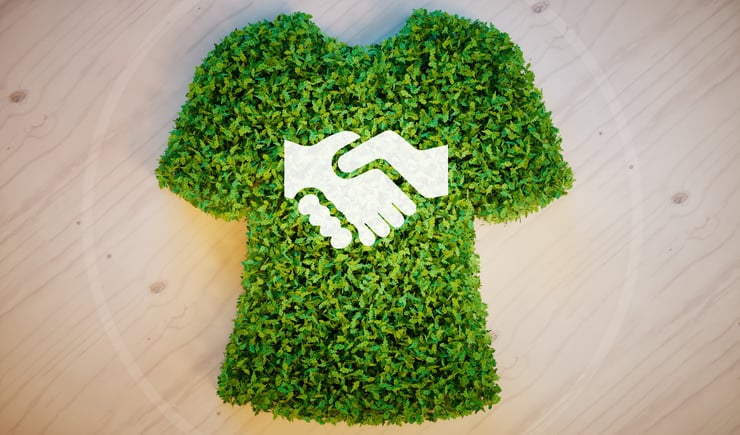As industries across the globe search for ways to improve their ecological footprint, you may be wondering what sustainable fabric options are available. When it comes to workwear, sustainable innovations have become commonplace. In the flame-resistant market, they are not so common just yet—but things are changing. Let’s explore some of the most popular options that are currently available in both areas.
Replacing virgin fibres for a smaller environmental footprint
To make fabrics more sustainable, there has been a move towards swapping out virgin fibres for recycled ones. For instance, some workwear fabrics now consist of recycled polyester. And there have also been a number of initiatives to replace virgin cotton with a more sustainable alternative.
The performance quality of such workwear fabrics is the same, while the impact on the environment is significant lower. Improvements are made on carbon footprint impact, water scarcity impact, the use of chemicals (fertilisers), energy consumption and/or social aspects throughout the textile chain.
To give you an idea of what the most in-demand sustainable fabrics on the market are, we’ve listed the most popular fabrics for workwear and protective workwear:
Popular sustainable fabrics for workwear
The most popular sustainable fabric solutions we currently see in the workwear market are two blends:
- a 65%/35% ratio of recycled polyester to cotton
- a 50%/50% ratio of recycled polyester to cotton
When it comes to cotton, there are a number of options to choose from, such as BCI, Fairtrade and organic cotton, as well as polyester blends with extra stretch characteristics.
Another popular choice is a blend where cotton is replaced by TENCEL™ lyocell. The ratios for these blends work out to:
- 65%/35% recycled polyester/TENCEL™ lyocell
- 50%/50% recycled polyester/TENCEL™ lyocell
Popular sustainable fabrics for flame-resistant protective workwear
Although sustainable fabrics for workwear are commonplace, they are quite new to the flame-resistant (FR) market, which provides fabrics for protective clothing. The most popular sustainable fabric solutions that we currently see in the FR market are the following blends:
- 50%/30%/19%/1% cotton/TENCEL™ lyocell/recycled polyester/anti-static
- 54%/45%/1% modacrylic/TENCEL™ lyocell/anti-static
In both markets (workwear fabrics and flame-resistant fabrics), the sustainable fabric solutions are available in several weights/constructions, dependent on the requirements of the industry they are used in.
For an in-depth overview of the most commonly used sustainable fibres in the textile market, read here more about what sustainable fibres are available.
Sustainability with added value for the wearer
Switching to sustainable fabrics does, of course, come at a premium. We are firm believers that sustainability without added value does not fly—there must be additional benefits in order to make the switch financially viable for businesses, too.
One such benefit is the improved comfort that TENCEL™ lyocell adds to every blend, both FR and non-FR. TENCEL™ lyocell absorbs 50% more moisture than cotton, which results in a better moisture management system and thus a dry feeling in hot working conditions. Examples of hot working conditions indoors are oil & gas refineries, paper and textile mills and metal foundries. Examples of hot working conditions outdoors are mid-summer repair jobs by utility and construction workers.
For inherent-FR, we see alternatives coming to market with TENCEL™ lyocell that better absorb dyestuff , resulting in less colour fading after industrial laundering. This is a marked improvement on cotton for instance, which can create whiteness on the seams after washing. As you can see, prioritising sustainability can pave the way for added value.
The premium for durable fabrics is higher than the prices we are used to for conventional workwear. Given the current cost price development due to the rising costs of raw materials, transport and energy, it’s a challenge to pass on the premium for conventional clothing to end customers — let alone adding a premium for sustainability. The question is whether customers are prepared to pay this.
The EPD® — giving you peace of mind
Advanced solutions like recycled polyester, bio cotton and TENCEL™ lyocell have been proven to perform better when it comes to overall lifecycle. Life cycle analysis is an important tool to measure the footprint of different fabrics. One way of doing this is by having an EPD® (Environmental Product Declaration) in place, which is verified by an independent reviewer. Our sustainable fabrics always come with an EPD®, so you can know how they will perform before purchasing them.
Sustainable fabrics in action
Keen to find out more about sustainable fabric options and how they can benefit your workplace? Why not have a read of our Infrabel Case Study. In this study, we explore how railway infrastructure manager Infrabel found a durable workwear solution that greatly reduced their garment waste as well as their ecological footprint.







.png?width=399&name=Risk%20management%20for%20PPE%20clothing%20in%20the%20EV%20and%20battery%20industries%20(5).png)
